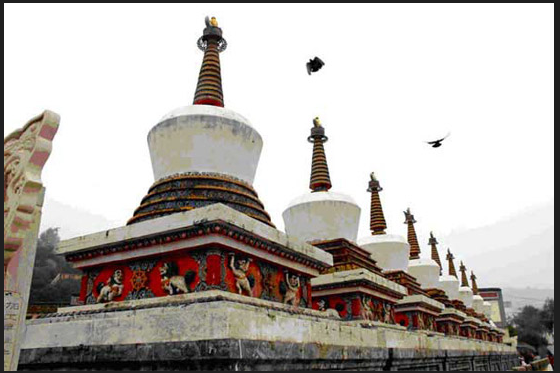Buddhist Stupas-Tibet

Tibetan buddhist stupa are symbolise of Buddha’s body, speech and mind. When the historical Buddha was cremated, his body was placed in a traditional Indian funeral cask to be cremated. This cask is called a Stupa ( in Tibetan we called it Choten). It has subsequently become for Buddhist what the cross is for Christian.
It is the preeminent symbol for the Buddha and his enlightenment, and the parts of the Stupa represent the different stages on the way to the final goal. There are eight principal forms of the Stupa, each of which stands for a particular aspect of the Buddha’s career.
The enlightenment Stupa symbolizes his illumination. The victory Stupa is his conquest of Mara(The Buddhist Satan). The Nirvana Stupa is his passing away and so forth. There are eight Stupas because after Shakyamuni’s body had been cremated, the relics were divided into eight parts,placed in eight smaller funeral casks,and taken to eight major ares in India where the Buddha had been active.
In Tibet when a great Lama died,his body would likewise be cremated in such a funeral cask and the relics then enshrined in a more ornate Stupa. The act of walking around a Stupa in a clockwise direction is considered by Tibetans and by Buddhists throughout Asia to generate great merit;which can then be dedicated towards the attainment of enlightenment.
Recent Posts
The Ultimate Guide to Tibet Tours, Travel, and Trekking Adventures
How to Explore Tibetan Culture
Exploring Lhasa:The Heart of Tibet
All Categories
- About Tibet
- book a Tibet tour
- Buddhism Practice
- Budget Tour
- China-Tibet Train
- Customized Tibet tour
- Historical Sites
- Hot Springs in Tibet
- News
- Photography in Tibet
- Tibet attraction
- Tibet Group Visa
- Tibet Motorcycle Tour
- Tibet Small Group Tours
- Tibet Tours and Tibetan Tour Guide
- Tibet Train
- Tibet Travel FAQs
- Tibet Travel Information
- Tibet Travel News
- Tibet Travel Permit Update
- Tibet Travel Prices Rises
- Tibet Trek
- Tibet Trekking Tour
- Tibet weather and climate
- Tibet Wildlife animals
- Tibet Winter Tour
- Tibetan Buddhism
- Tibetan Cultural Features
- Tibetan Culture and Poeple
- Tibetan Festivals
- What to see in Tibet



